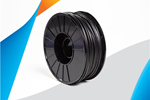Braskem demonstrates PP solutions using Weav3D composite lattice technology
Partnership combines Braskem’s polypropylene sheets with Weav3D Rebar for Plastics technology to address new structural, automotive applications requiring high-strength, lightweight material solutions.
Beltline stiffener for automotive produced using Braskem and Weav3D technologies. Photo Credit: Braskem
Polyolefins and biopolymers producer Braskem (Philadelphia, Pa., U.S.) announces a demonstration of the company’s polypropylene (PP) polymer in combination with Weav3D Inc. (Norcross, Ga., U.S.), an advanced manufacturing and materials startup, leveraging Weav3D’s thermoplastic composite lattice technology to enhance the performance of PP for structural and automotive material applications.
The Weav3D lattice technology enables thermoplastic composite lattice structures at high volumes for use as reinforcements in concrete, plastic or composite components in a range of industries, replacing materials like steel. The combination of Braskem PP sheets with Weav3D’s Rebar for Plastics — a woven composite lattice reinforcement comprised of unidirectional, fiber-reinforced composite tapes — will enable Braskem to compete in new structural material end markets, such as automotive.
“As the automotive industry continues to roll out new electric vehicle designs, it requires automakers to rethink the vehicle design with cutting-edge performance materials,” Amanda Zani, technology platform manager, Braskem, explains. “With significant improvements in lightweighting, reduced costs and higher material efficiency, combining Braskem’s PP portfolio with Weav3D composite lattices provides a ‘win-win’ in terms of enhanced material performance and a more sustainable environmental impact, including the integration of natural fiber options.”
Benefits of using Weav3D’s Rebar for Plastics and Braskem PP versus conventional composite organosheets include reducing sheet blank weight by ~50% and final part weight by ~20%, cutting costs by ~50% and increasing sheet yield from 25% to 45% by weight, resulting in a 63% reduction in trim waste.
“Braskem has been a fantastic partner throughout this project and really demonstrated a strong commitment to sustainable materials innovation,” Chris Oberste, president of Weav3D, says. “Leveraging Braskem’s diverse polypropylene portfolio and deep technical expertise, we worked collaboratively with the Braskem team to identify the right combination of Braskem PP and reinforcing lattice material in order to minimize cost and maximize performance, while achieving formability and sustainability goals.”
Related Content
-
SMC composites progress BinC solar electric vehicles
In an interview with one of Aptera’s co-founders, CW sheds light on the inspiration behind the crowd-funded solar electric vehicle, its body in carbon (BinC) and how composite materials are playing a role in its design.
-
Automotive chassis components lighten up with composites
Composite and hybrid components reduce mass, increase functionality on electric and conventional passenger vehicles.
-
“Structured air” TPS safeguards composite structures
Powered by an 85% air/15% pure polyimide aerogel, Blueshift’s novel material system protects structures during transient thermal events from -200°C to beyond 2400°C for rockets, battery boxes and more.
















